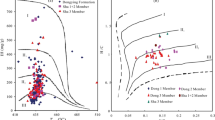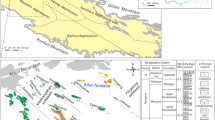Abstract
Through natural gas exploration in the Changling Fault Depression, abundant natural gas flows were obtained and high-quality source rocks were also reveiled. Based on bulk analyses, organic matter abundance, organic matter type and thermal maturity of the source rocks were studied systematically. At the same time, gas generating intensity and gas generating quantity were quantitatively analyzed by using basin modeling technologies. The results indicated that gas source rocks of the Shahezi Formation are characterized by abundant organic matter and dark mudstone distributions and high-over thermal maturity. They possess high gas generating intensity with the biggest value surpassing 500×108 m3/km2, and large gas generating quantity, accounting from 74.40% of the total amount. The Yingcheng Formation has good gas-source rocks with moderate dark mudstone and relatively high organic matter. It has type-III organic matter and low-over thermal maturity. The gas generating intensity is moderate, between 20×108 and 60×108 m3/km2. The gas generating quantity is 13.63% of the total amount. The Huoshiling Formation has relatively good source rocks with limited dark mudstone and low organic matter. It has type-III kerogen and over-thermal maturity. The gas generating quantity is 7.10% of the total amount. The Denglouku Formation has poor-gas source rocks, and is characterized by undeveloped dark mudstone and low organic matter abundance. It has type-III organic matter and low-high thermal maturity. Hydrocarbon gases in the Changling Fault Depression mainly originated from the Shahezi Formation, and secondarily from the Yingcheng Formation. The contribution of the Huoshiling Formation gas source rocks is relatively small.
Similar content being viewed by others
References
Amer M. Burgan and Che Aziz Ali (2009) An organic geochemical investigation on organic rich sediments from two Neogene formations in the Klias Peninsula area, West Sabah, Malaysia [J]. Chinese Journal of Geochemistry. 28, 264–270.
Dai Jinxing, Zou Caineng, Tao Shizhen, Liu Quanyou, Zhou Qinghua, Hu Anping, and Yang Chun (2007) Formation conditions and main controling factors of large gas fields in China [J]. Natural Gas Geoscience. 18, 473–484 (in Chinese with English abstract).
Hao Shisheng, Gao Gang, Wang Feiyu, and Gang Wenzhe (1996) High-over Maturative Marine Hydrocarbon Source Rocks [M]. pp.7–133. Petroleum Industry Press, Beijing (in Chinese with English abstract).
Li Xiaofeng, Peng Shimi, and Shao Ming (2009) Origin and gas-source correlation of the deep gas in the Songliao Basin: A case study of the Yingcheng Formation gas reservoir in Changshen-1 Block of Changling fault depression [J]. Natural Gas Industry. 29, 5–8 (in Chinese with English abstract).
Shi Guangren (2009) Review and outlook for the 30th anniversary of basin modeling techniques [J]. Computer Applications of Petroleum. 61, 3–6 (in Chinese with English abstract).
Tenger, Liu Wenhui, Xu Yongchang, Chen Jianfa, Hu Kai, and Gao Changlin (2006) Comprehensive geochemical identification of highly evolved marine hydrocarbon source rocks: Organic matter, paleoenvironment and development of effective hydrocarbon source rocks [J]. Chinese Journal of Geochemistry. 25, 332–339.
Wang Tieguan, Zhong Ningning, Xiong Bo, Li Xianqing, and Huang Difan (1994) Organic petrologic methodology for evaluation of hydrocarbon generation potential in source rocks [J]. Acta Petrolei Sinica. 15(4), 9–16 (in Chinese with English abstract).
Xia Xinyu (2000) Generating Hydrocarbon Potentiality of Carbonate Rocks and the Changqing Gasfield [M]. pp.28–59. Petroleum Industry Press, Beijing (in Chinese).
Yan Weipeng, Li Jianzhong, Wang Liwu, Zhang Qingchun, Yang Tao, Ma Yan, and Zheng Man (2009) Prediction of the deep natural gas potential of Changling Fault Depression, Songliao Basin [J]. Geoscience. 23, 902–907 (in Chinese with English abstract).
Zhang Houfu, Fang Chaoliang, Gao Xianzhi, Zhang Zhihuan, and Jiang Youlu (1999) Petroleum Geology [M]. pp.86–87. Petroleum Industry Press, Beijing (in Chinese).
Zhang Yuming, Li Ming, and Li Ruilei (2006) Reservoiring pattern of natural gas in deep of southern Songliao basin [J]. Oil and Gas Geology. 27, 841–848 (in Chinese with English abstract).
Zhang Zhihuan, Wu Yuyuan, Yu Kai, Wu Shuiping, and Liu Hongjun (2002) Geochemical characteristics of source rocks in Changling area, Songliao Basin [J]. Xinjiang Petroleum Geology. 23, 501–506 (in Chinese with English abstract).
Zhou Liqing, Lei Yixin, and Wang Hongyan (2009) Play types and distribution features of coexistence of organic and abiogentic hydrocarbon in the Changling Faulted Depression of SongLiao Basin [J]. Petroleum Geology & Experiment. 31, 324–328 (in Chinese with English abstract).
Author information
Authors and Affiliations
Corresponding author
Rights and permissions
About this article
Cite this article
Zan, L., Zhang, Z., Fei, J. et al. A study on hydrocarbon generation potential of deep source rocks and gas sources in Changling Fault Depression, Songliao Basin. Chin. J. Geochem. 30, 255–263 (2011). https://doi.org/10.1007/s11631-011-0507-5
Received:
Accepted:
Published:
Issue Date:
DOI: https://doi.org/10.1007/s11631-011-0507-5




